Roman Naval Warfare › Sicily » Ancient origins
Articles and Definitions › Contents
- Roman Naval Warfare › Who Was
- Sicily › Ancient History
Ancient civilizations › Historical and archaeological sites
Roman Naval Warfare › Who Was
Definition and Origins
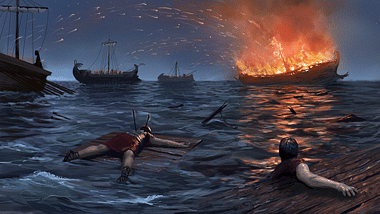
Military supremacy of the seas could be a crucial factor in the success of any land campaign, and the Romans well knew that a powerful naval fleet could supply troops and equipment to where they were most needed in as short a time as possible. Naval vessels could also supply beleaguered ports under enemy attack and, in turn, blockade ports under enemy control. A powerful navy was also indispensable to deal with pirates, who wreaked havoc with commercial sea-traders and even, on occasion, blockaded ports. Naval warfare had its own unique dangers, though, with adverse weather being the biggest threat to success, which is why naval campaigns were largely limited to between April and November.
SHIPS & WEAPONS
Ancient naval vessels were made of wood, water-proofed using pitch and paint, and propelled by both sail and oars. Ships with multiple levels of rowers, such as the trireme, were fast and manoeuvrable enough to attack enemy vessels by ramming. The largest ships were the quinqueremes, with three banks of rowers, two each for the upper two oars and one rower on the lower oar (around 300 in total). Ships could also be fitted with a platform via which marines could easily board enemy vessels - a device known as the corvus (raven). Built for speed, most warships were lightweight, cramped, and without room for storage or even a large body of troops. Such logistical purposes were better achieved using troop carrier vessels and supply ships under sail.
Aside from the bronze covered battering ram below the water-line on the ship's prow, other weapons included artillery ballista which could be mounted on ships to provide lethal salvoes on enemy land positions from an unexpected and less protected flank or also against other vessels. Fire balls (pots of burning pitch) could also be launched at the enemy vessel to destroy it by fire rather than ramming.
PERSONNEL
Fleets came to be commanded by a prefect ( praefectus ) appointed by the emperor, and the position required someone with great skill and leadership qualities to successfully marshal a fleet of sometimes unwieldy vessels. The captain of a vessel held centurion rank or the title of trierarchus. Fleets were based at fortified ports such as Portus Julius in Campania which included artificial harbours and lagoons connected by tunnels. Crews of Roman military vessels could be trained in such ports but they were, in reality, more soldiers than sailors as they were expected to act as light-armed land troops when necessary.Indeed, they are typically referred to as miles (soldiers) in documents and funeral monuments, and they also received the same pay as infantry auxiliaries and were similarly subject to Roman military law. Crews were typically recruited locally and drawn from the poorer classes (the proletarii ) but could also include recruits from allied states, prisoners of war, and slaves.Training was, therefore, a crucial requirement, so that the collective manpower was used most efficiently and discipline was maintained in the frenzy and horror of battle.
ROME 'S NAVY SWEPT AWAY THE CARTHAGINIANS AND CILICIAN PIRATES, BRINGING TOTAL DOMINATION OF THE MEDITERRANEAN.
TACTICS
Roman naval tactics differed little from the methods employed by the earlier Greeks. Vessels were propelled by rowers and sail to transport troops, and in naval battles the vessels became battering rams using their bronze-wrapped rams. In actual battle, sailing manoeuvrability was limited and so rowers propelled the vessels when at close quarters with the enemy. Sails and rigging were stored on shore which saved weight, increased the vessel's stability, and left more room for marines. The objective was to position the ram to punch a hole in the enemy vessel and then withdraw to allow water into the stricken ship.Alternatively, a well-aimed swipe could break one bank of the enemy's oars and thus disable it. To achieve this sort of damage, the best angle of attack was to the enemy's flank or rear. Therefore, not only was manoeuvrability under oar a necessity but so too was speed. This is why, over time, vessels had more and more rowers, not along the ship's length which would make the ship unseaworthy, but by piling rowers on top of each other. Thus the trireme of the Greeks, with three levels of rowers, had evolved from the brireme with two levels, and the trireme eventually evolved into the Roman quinquereme.
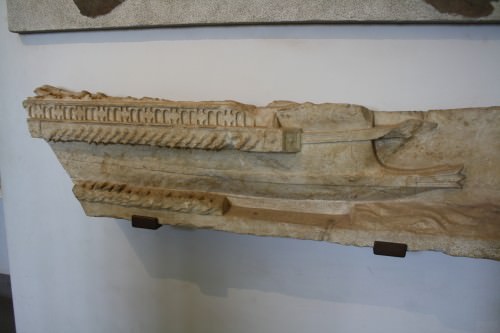
Roman Naval Vessel
AGAINST CARTHAGE
Rome had employed naval vessels from the early Republic in the 4th century BCE, especially in response to the threat from pirates in the Tyrrhenian Sea, but it was in 260 BCE that they built, in a mere 60 days, their first significant navy. A fleet of 100 quinqueremes and 20 triremes was assembled in response to the threat from Carthage. In typically Roman fashion, the designers copied from, and improved upon, a captured Carthaginian quinquereme.
The Romans had also recognised the inferiority of their seamanship compared to the much more experienced Carthaginians.For this reason they employed the corvus. This was an 11 metre long platform which could be lowered from the ship's bow on to the decks of enemy vessels and fixed via a huge metal spike. Roman troops (around 120 on each ship) could then board the opposing vessel and make short work of the enemy crew.
The first engagement where the corvi were employed with great effect was the Battle of Mylae off the coast of northern Sicilyin 260 BCE. The two fleets were evenly matched with 130 vessels apiece, but the Carthaginians, not expecting the Romans to be any great shakes at naval warfare, did not even bother to form battle lines. The corvus proved a devastatingly successful attack weapon against the disorganised Carthaginians, and a Roman victory was the result, albeit, an unexpected one. Not only did the commander and consul Caius Duilius have the satisfaction of seeing his opposite number flee his flagship in a rowing boat, but he was also granted a military triumph for this, Rome's first great victory at sea.
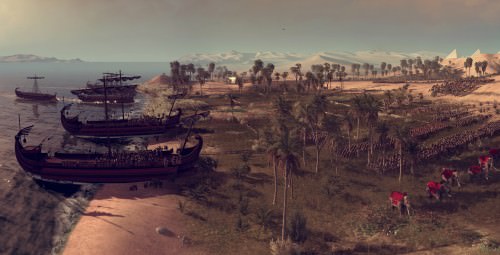 NAVAL LANDING
NAVAL LANDING

ECNOMUS
The Battle of Ecnomus, in 256 BCE off the southern coast of Sicily, was one of, if not the, largest sea battles in ancient times, and it would show that Mylae had been no fluke. The Romans, buoyed by their first success, had expanded their fleet so that they now had 330 quinqueremes with a total of 140,000 men ready for battle. The Carthaginians set sail with 350 ships, and the two massive fleets met off the coast of Sicily. The Romans organised themselves into four squadrons arranged in a wedge shape. The Carthaginians sought to entice the front two Roman squadrons away from the rear two and catch them in a pincer movement. However, whether through a lack of manoeuvrability or proper communication of intentions, the Carthaginian fleet instead attacked the Roman rear transport squadron whilst the front two Roman squadrons caused havoc inside the Carthaginian centre. In the close-quarter fighting, seamanship counted for little and the corvii for everything. Once again, victory was Rome's. Carthage lost 100 ships to a mere 24 Roman losses.
The war dragged on, though, as Rome's immediate invasion of North Africa proved a costly failure. A notable expedition led by Gnaeus Servilius Rufus in 217 BCE cleared Italian waters of Carthaginian raiders and the Romans did eventually defeat the Carthaginian fleet, but largely because they were able to replace lost ships and men quicker in what became a war of real attrition. Victories were mixed with defeat at Drepna in 249 BCE and disasters such as the loss of 280 ships and 100,000 men in a single storm off the coast of Camarina in south-east Sicily, but, eventually, Rome prevailed. The war had cost Rome 1,600 ships but the prize was worth it: domination of the Mediterranean. This sea control became useful in Rome's wars with the successor kingdoms of Alexander in the Macedonian Wars. Between 198 and 195 BCE, for example, Rome repeatedly launched successful sea-borne raids against Philip V of Macedonia's ally Nabis, the Spartan tyrant.
POMPEY & PIRATES
With the decline of Rhodes, which had for centuries policed the Mediterranean and Black Sea to protect her lucrative trade routes, piracy became rife in the 1st century BCE. More than 1,000 pirate ships, often organised along military lines with fleets and admirals, were now the scourge of sea-trade. They also grew in confidence, acquiring triremes and even raiding Italyitself, attacking Ostia and disrupting the all-important grain supply. In 67 BCE Rome once more amassed a fleet, and Pompey the Great was given the task of ridding the seas of the pirate pest in three years.
With 500 ships, 120,000 men, and 5,000 cavalry at his disposal, Pompey divided his force into 13 zones and, himself leading a squadron, first cleared Sicily, then North Africa, Sardinia, and Spain. Finally, he sailed for Cilicia in Asia Minor, where the pirates had their bases and where they had been deliberately allowed to gather by Pompey for a last decisive battle. Attacking by sea and land, and victorious in the battle of Coracesium, Pompey negotiated a pirate surrender with a sweetener of free land for those who gave themselves up peacefully. The last threat to Rome's complete control of the Mediterranean was gone.
EVENTUALLY, THE ONLY THREAT TO ROME WAS ROME HERSELF AND, SO IT WAS, CIVIL WAR RAVAGED ITALY.
CIVIL WAR
Now the only threat to Rome was Rome herself and, so it was, civil war ravaged Italy. Julius Caesar emerged the victor, and the remnants of Pompey's fleet became the backbone of the Roman navy, which was used to good effect in the expeditions to invade Britain - the larger second expedition in 54 BCE involved a fleet of 800 ships. Following Caesar 's assassination, the fleet came under the control of Sextus Pompeius Magnus, ironically, the son of Pompey. By 38 BCE Octavian, Caesar's heir, had to amass another fleet to meet the threat of Sextus. Giving command to Marcus Vipsanius Agrippa, 370 vessels were dispatched to attack Sicily and the fleet of Sextus. Once again, a lack of well-trained seamen forced commanders to innovate, and Agrippa went for brute force over manoeuvrability and employed a catapult propelled grapnel on his vessels. This device allowed ships to be winched into close quarters to facilitate boarding by marines. The weapon proved devastatingly effective in 36 BCE at the 600-ship battle of Naulochos (Sicily again), and Sextus was defeated.
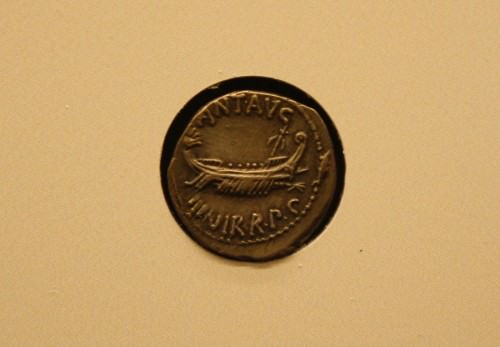
Praetorian Galley
ACTIUM
In 31 BCE, near Actium on the western coast of Greece, there occurred one of the most significant naval battles in history.Still battling for control of the Roman Empire, Octavian now faced Mark Antony and his ally, Egyptian Queen, Cleopatra.Both sides amassed a fleet and made ready to attack the other. Mark Antony led a fleet of 500 warships and 300 merchant ships against Octavian's similar-sized force, although Antony had larger and less manoeuvrable Hellenistic -type vessels.Agrippa, still in command, launched his attack early in the sailing season and so caught Antony by surprise. The northern outposts of Antony's forces were the target, a move which created a diversion whilst Octavian landed his army. In any case, Antony refused to be drawn from his fortified harbour in the Gulf of Ambricia. Blockade was Agrippa's only option. Perhaps, Antony was playing for time, waiting for his legions to assemble from around Greece. Octavian, though, would not be drawn into a land battle and dug-in his fleet behind a defensive mole 8 km to the north. As disease ravaged his troops and his supply lines became increasingly threatened by Agrippa, Antony had little choice but to try and break out on the 2nd of September.Not helped by a defector giving Octavian his plans and several generals switching sides, Antony could only muster 230 ships against Agrippa's 400.
Agrippa's strategy was to hold station at sea and lure Antony away from the coast. However, this would have exposed Antony to the greater manoeuvrability of Agrippa's vessels, so he tried to hug the coast and avoid encirclement. As the wind rose around noon, Antony saw his chance for escape as his fleet was under sail whilst Agrippa's had stowed their sails on shore, standard practice in ancient naval warfare. The two fleets met and engaged and in the confusion, Cleopatra's 60-ship squadron fled the battle. Antony quickly followed suit; abandoning his flagship for another vessel, he followed his lover and left his fleet to be crushed by Agrippa and Octavian's combined forces. Soon after, Antony's land army, now leaderless, surrendered to Octavian with a negotiated peace. The propaganda of the victors predictably blamed Cleopatra and Antony's cowardice for the defeat, but the fact that Antony had engaged Agrippa under sail suggests that, heavily outnumbered, he had, from the start, intended flight rather than combat.
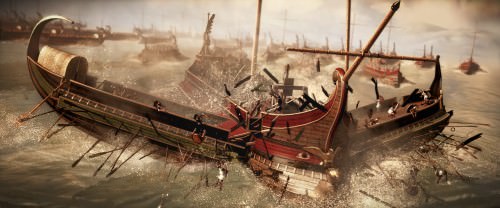
Trireme Ramming
ROME STANDS ALONE
Following victory at Actium, the new emperor Octavian, now calling himself Augustus, established two 50-ship fleets - the classis Ravennatium based at Ravenna and the c lassis Misenatium based at Misenum (near Naples), which were in operation until the 4th century CE. There were also later fleets based at Alexandria, Antioch, Rhodes, Sicily, Libya, Pontus, and Britain, as well as one operating on the Rhine and another two on the Danube. These fleets allowed Rome to quickly respond to any military needs throughout the empire and to supply the army in its various campaigns. In truth though, there was no real naval competition to Rome's fleets. This is evidenced by the fact that in the following centuries, Rome was involved in only one more major naval battle - in 324 CE between emperor Constantine and his rival Licinius - and so, in the ancient Mediterranean at least, after Actium, the days of large-scale naval battles were over.
Sicily › Ancient History
Definition and Origins
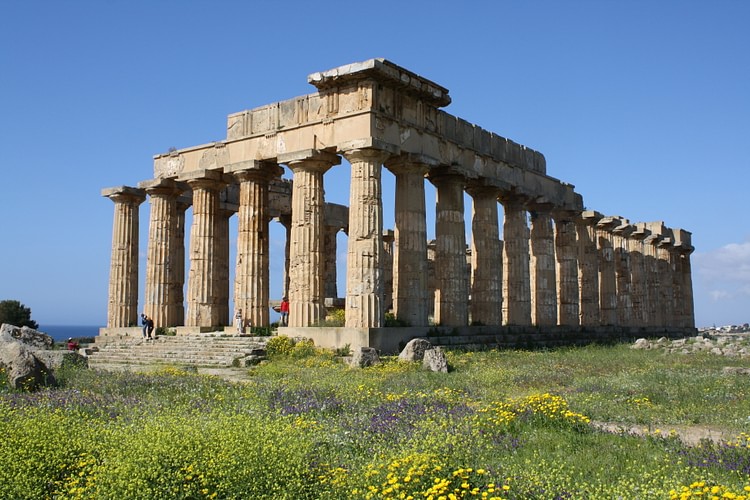
The Mediterranean island of Sicily, with its natural resources and strategic position on ancient trading routes, aroused the intense interest of successive empires from Carthage to Athens to Rome. Consequently, the island was never far from centre-stage in regional politics and was very often a theatre of war throughout the Classical period. Invasions, tyrants, and battles did, though, eventually give way to centuries of relative peace and prosperity as a Roman province. Sicily's historical legacy today includes some of the most impressive and best-preserved ancient monuments in the Mediterranean, testimony to the island's rich cultural history.
EARLY HISTORY
There were three indigenous groups on ancient Sicily: the Elymi in the western part of the island, the Sicani in the centre, and the Sicels in the east - the latter being the root of the island's name. According to Thucydides, the origins of these groups could be traced back to Troy, Iberia, and mainland Italy, respectively. Finds of pottery and copper ingots indicate that the island traded with Late Bronze Age peoples such as the Mycenaeans and Cypriots. Although traditional accounts have the Phoenicians as the first colonisers there is no evidence that they pre-dated Greek colonists. Motya, Panormus and Soloeis were the principal Phoenician settlements whilst Segesta, Eryx and Entella were the main Elymi sites, all of which were allied to Carthage. Greek colonisation began c. 735 BCE and exerted a strong political and cultural influence on local communities either directly or via trade. This Hellenization was most evident in architecture with great Doric temples being built across the island. The spread of urban settlements and the first issues of Sicilian coinage in the late 6th century BCE attest to the prosperity enjoyed by many of the city -states or poleis. The Phoenician settlements rigorously rebuffed the Greek advancement into their territory, notably in c. 580 BCE against Pentathlus and again in c. 510 BCE against Dorieus.
TYRANTS, CARTHAGE, & ATHENS
The form of government of the various poleis followed the various Greek models but tyrants were prevalent. Acragas ( Agrigento ) and Gela were amongst the earliest poleis to be ruled by tyrants and Hippocrates of Gela was the first of a long line of famous Sicilian tyrants (it should be noted that the Greek term 'tyrant' signified a single ruler and he was not always a tyrant in the modern, negative sense of the term). Hippocrates' successor was Gelon (r. 491-478 BCE), and he moved his capital to Syracuse which had originally been founded as a colony of Corinth in 734 BCE. Syracuse would, following the defeat of Carthage and her Sicilian allies at the battle of Himera in 480 BCE, become the dominant polis on the island and second only to Athens as the largest in the Greek world, eventually over-taking it in terms of population.
ONE OF SICILY'S GREATEST RULERS WAS THE GIFTED GENERAL, POLITICIAN, AND PATRON OF THE ARTS, THE TYRANT DIONYSIUS I.
From the 5th century BCE, democracy became the dominant form of government, but the still mutually independent poleis now began to attract the interest of the great maritime power of the age: Athens. A first unsuccessful attempt to increase Athenian influence in the region between 427 and 424 BCE was followed by the spectacular flop known as the Sicilian Expedition between 415 and 413 BCE. Attacking Syracuse, the Athenian plan was masterminded by Alcibiades, but ultimately the Athenians came unstuck and lost their entire invasion force. Athens had over-estimated any local support they might have received from disgruntled Sicilian poleis and under-estimated the fortifications and resolve of the Syracusans. When Gylippus arrived with a relief force from Corinth, the fate of the Athenians was sealed and their two commanders were executed in a shocking blow to Athenian military pride.
Syracuse then became an active ally to Sparta as the Peloponnesian War rumbled on against Athens and her allies.Carthage, meanwhile, seized the opportunity to increase her influence, capturing Selinus and Himera in 409 BCE and then Acragas and Gela three years later. Syracuse regained the initiative, however, under the rule of one of the greatest leaders in the island's history: Dionysius I, gifted general, politician and patron of the arts. Taking power in 405 BCE and employing a large mercenary army, Syracusan domination of the island followed, and the Carthaginians could only maintain a toe-hold in the west, a situation which remained unchanged until the death of Dionysius in 367 BCE. Dionysius also became a useful ally to Sparta during the Corinthian Wars between 395 and 386 BCE, and he expanded the Syracusan Empire to include large parts of the southern Italian mainland. He was an innovative military leader and is credited with employing siege towers and bolt throwing artillery for the first time in Greek warfare.

Bikini Mosaic
HELLENISTIC & ROMAN SICILY
In the Hellenistic period, and following the end of Dionysius I's reign, Syracuse was obliged to call on Corinth to help meet the threat of Carthage. Timoleon duly brought victory at the battle of Crimisius c. 341 BCE, and he re-established Syracusan control of her kingdom, eliminating tyrannies and embarking on a programme of restoration and encouraging a new influx of colonists from Greece and Italy. Many Sicilian states once more prospered, but after the death of Timoleon, political chaos ensued. However, following a tumultuous period of oligarchic rule, a powerful tyrant once more revived the fortunes of Syracuse. Agathocles took power in 317 BCE and declared himself king of Sicily in c. 305 BCE, after seizing most of the island. Once again, though, when a strong individual ruler died, unrest and decline swiftly followed. The fortunes of the city revived under the 3rd century BCE rulers Pyrrhus and Hieron II, but Sicily as a whole was, in the coming decades, about to lose its independence.
Carthage continued to be an ever-present threat to Sicilian cities, but by the mid-3rd century BCE a new player had arrived on the scene: Rome. The two great powers would clash in the Punic Wars and Sicily became the battleground. Rome eventually won the day and Sicily became a Roman province, what would be the first of many. Hieron II of Syracuse had switched sides to join Carthage, but with the city's fall at Roman hands in 211 BCE, the island was at last unified into a single governable unit ruled by a foreign power.
The Romans differentiated between certain cities in their new province depending on their past allegiances, and some had more political freedom and less of a tax burden than others but, generally, with the Roman concern to guarantee a reliable grain supply, the island prospered into the imperial period and Greek and Latin cultures co-existed. Augustus created several colonies for veterans on the island and agriculture flourished with the establishment of many large, imperial estates, so that Sicily became an important producer of wine, wool and timber. Over time Sicily's importance to Rome waned, but Syracuse did become an important Christian centre and remained one right up to the 7th century CE.
LICENSE:
Article based on information obtained from these sources:with permission from the Website Ancient History Encyclopedia
Content is available under License Creative Commons: Attribution-NonCommercial-ShareAlike 3.0 Unported. CC-BY-NC-SA License